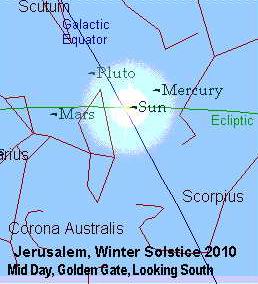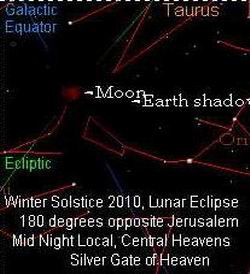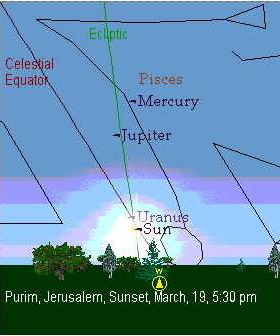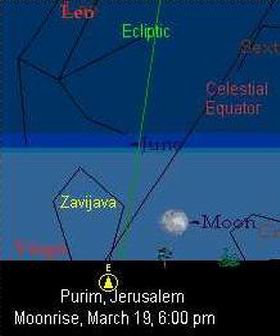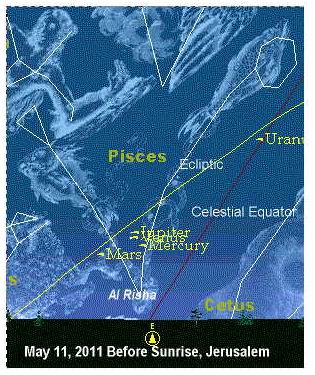|
|
Purim and a Rare Spring Equinox in the 13th
Month Spring 2011Steve Santini The date and celestial configurations associated with this year's Hebrew feast of Purim make it a significantly unique occurrence. This year the two-day feast of Purim falls on March 19th and 20th. It begins as the western sunset and the eastern full moonrise coincide about 6 pm Jerusalem time on the 19th. Then during the next night on the 20th of March, the spring equinox occurs about midnight with the nearly full moon centrally located in the heavens. Purim is the annual feast in dedication to the deliverance of the Jewish people from a national death decree when held captive within Persia in the 5th century BC. The biblical book of Esther tells the story of evil Haman's plot to exterminate those Jews in Persia and of God's deliverance and reversal through the wisdom of queen Esther and her cousin Mordecai. Normally, Purim does not occur during the later part of the month of March. It usually falls on a full moon day in the month of February or early March. Since the Hebrew calendar is based on the lunar months of about 28 days, their calendar progressively falls behind the solar calendar of 365 days. So about every five years, one month is added to their calendar. This month is added at the end of their religious year that begins in the spring with the month of Nisan when the first fruits of barley are ripe. The last month of the Hebrew year is named Adar. The added lunar month is named Adar II and is the 13th lunar month for that year. (According to EW Bulinger's Companion Bible, the number 13 biblically denotes rebellion, apostasy, defection, disintegration and revolution.) In the case of the year with an added Adar, Purim is celebrated on the full moon day or the 14th of the second Adar rather than that day in the first Adar of that year. It is also not often that the spring equinox falls in such close proximity to the full moon day in the month of March whether during Purim or not. It, too, so happens, that on this weekend of March 19th and 20th of Purim and the spring equinox, the moon will be at perigee or closest to earth. Perigee of the moon occurs about every twenty years but quite rarely on such significant dates as these. Another feature of this year's Purim that makes it significantly unique is the relatively unusual fact that the sun will be at the precise point in Pisces where the celestial equator crosses the ecliptic. This means that the full moon will be located at and near the other crossing of the celestial equator and the ecliptic across the celestial sphere within Virgo during the two-day feast of Purim. There are two other points along the ecliptic that are well-noted crossings. These two stationary points are where the circle of the galactic equator and the circle of the ecliptic intersect. One of these intersections is between Sagittarius and Scorpio under the feet of Ophiuchus, the companion sign of Hercules in which both heads share the bright star, Ras Al Awa meaning head of the desired. This intersection below Ophiuchus is known as the golden gate of heaven. The other intersection of the galactic equator and the ecliptic is also across the heavens between Taurus and Gemini above the raised arm of Orion. It was known as the silver gate of heaven. In these two gates the heavens are now portraying what seems to be the most relevant signs of the last 2000 years if not the last 26,000 years. Within a present 72 year span the sun is located in the golden gate of heaven on each winter solstice and then located in the silver gate of heaven on each summer solstice uniquely during this span. During this past year, the sun was in the golden gate of heaven on the winter solstice while, at the same time, the full moon was located across the heavens in the silver gate of heaven resulting in a quite rare lunar eclipse for the annual date of the winter solstice .
These four intersections spaced around the ecliptical cycle of the heavenly zodiac are important markers. The bright star in the star group Awa within Virgo nearest to the present crossing of the celestial equator and the ecliptic is anciently named as Zavijava. It means the corner as in the furthermost turning point. During the onset of Purim on March 19th the full moon will be in conjunction with this bright star Zavijava. This timing and associated symbolic meanings leads one to consider that these four intersections of the ecliptic could be the four anciently recognized corners of heaven from which the potentially destructive winds were said to blow. The preceding features that make this Purim unique are: it will start on the 13th lunar month's mid point night of the full moon; its first day will coincide with a Sabbath, its duration will include the night of the spring equinox, its second day will be the beginning of a new week according to the Hebrew week, the full moon will be in Awa encompassing the point where the celestial equator crosses the ecliptic and the sun will be at the other point in Pisces where the celestial equator crosses the ecliptic.
Celestial events of this magnitude must be considered in the scope and context of their occurrences. Jupiter, the ruling planet representing the king of righteousness, has been residing in Pisces since early April of 2010. It will not leave Pisces until late June 2012. During its time in Pisces it will have been in two distinct retrograde zones. The Magi and the Chaldean and Babylonian priests all considered the movement of planets in their retrograde zones as significant for their celestial interpretations; especially, those retrograde zones that included triple conjunctions with brighter, nocturnal, celestial lights. From April 29, 2010 till Feb 8, 2011 Jupiter was in a retrograde zone under the fish of Pisces that swims beside the path of the ecliptic. From June 6, 2011 till March 17, 2012 Jupiter will be in a retrograde zone during which it makes a triple conjunction with the central bright star of Pisces named Al Risha and meaning the knot tied as in marriage. Mercury entered Pisces on March 4, 2011 and will depart Pisces on May 17, 2011. In antiquity the planet Mercury was known as coming as in going and coming. Later in Greek mythology Mercury was known as a messenger. Biblically, Mercury is associated with the messenger archangel Gabriel. Mercury was in an interesting retrograde during the last winter solstice when the full lunar eclipse occurred. From November 22, 2010 till January 18, 2011 Mercury was in retrograde making a triple conjunction with the golden gate of heaven. From March 16, 2011 till May 11, 2011 Mercury will be in its next retrograde zone located within Pisces during which it makes a triple conjunction with Jupiter. During this time Mercury will also make two very close conjunctions with both Venus and Mars respectively. This retrograde span of Mercury will also encompass Passover and the Feast of Unleavened Bread from April 18th trough the 26th. On May 11th as Mercury is leaving its retrograde zone in Pisces, Jupiter, Venus and Mercury will be tightly massed together between the two bands that unite the two fishes of Pisces. Some ancient cultures of Anatolia believed that Venus represented the love between a newly betrothed young man and young woman.
Both Pisces and Awa, where the two crossings of the celestial equator and the ecliptic occur, represent the combination of masculine and feminine energies. Awa is a star grouping in Virgo that spans from the upraised right arm of Virgo through her womb to her left shoulder from which her lower arm is extended. More ancient depictions of Virgo show her holding a stalk of barley in her upraised right hand. Barley was considered as masculine in antiquity. Virgo's lower left had holds a stalk of wheat. Wheat was considered as feminine. In bread making, which was central to ancient daily life, the barley spores from leaven inserted atop the dough caused the wheat loaf to rise much like the masculine impregnation of the feminine caused her womb to rise. Pisces is depicted as two fishes held together by their respective bands. The bands are united at the point of Pisces brightest star, Al Risha, meaning, as said, the knot tied as in marriage. The Eastern wedding ceremony included a time when the groom tied the knot in the linen sash that girded his brides robe. Today in India, during the Hindu wedding ceremony, the groom knots a loosely hanging red cord around his bride's neck. Today, even in the western culture, males speak idiomatically of marriage as tying the knot. The fish of Pisces that swims counter clockwise along the ecliptic is consider feminine. The other fish swimming upward through Andromeda to the celestial heights at the feet of the enthroned Cepheus and Cassiopeia in the midst of the Milky Way is considered as masculine. Fish, biblically, represent the soul part of humans. So, one might say that Pisces represents heavenly soul mates. Purim represents a change in or reversal of circumstances. It seems now, more than ever, that man is crying for a universal change where there is genuine daily sustenance for body, soul, and spirit. May this year's Purim be a hopeful stepping-stone unto that day when these promises of the Father are fulfilled through his son, the Lord Jesus Christ. The Series: Galactic Alignment And Christ On Observing the
Celestials
Introduction and Main Index
Copyright, Steven
G. Santini, 2011 |
